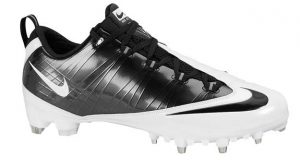Identify:
The earliest use of cleats has been reported since 1525 when King Henry VIII had a pair of soccer cleats. Since then, their design has changed drastically in order to accommodate changes in sports and technology. Today in sports there are many varieties of cleats that each provides their own advantages and disadvantages. However, as safety becomes a priority in modern sports regulation, certain cleat materials are beginning to become banned from use. Metal spikes present a hazard to players who may be stepped on or kicked. So there is a need for new cleats to be made from less hazardous materials that still provide the facilitation of rapid acceleration and deceleration in athletes.
Figure 1: A low-cut cleat with metal studs.
When athletes accelerate or change direction there is a great deal of force that is placed between the shoe and the ground. In order to prevent slips, studs on the bottom of shoes are necessary so that greater amounts of force can be reached. These studs can be replaceable or permanently attached to the sole of the shoe. Depending on the amount of force, the studs must be designed with a large enough surface area of attachment to withstand the shear stress. By understanding how much shear force each cleat stud will experience, it is possible to design a shoe with large enough studs that will not break off of the shoe when the user is accelerating.
Formulate:
In order to design a cleat able to withstand the forces of athletes there are several factors to consider. The material that is being used in the design of this cleat is rubber which provides stability and strength without the dangers of metal studs. The force applied to the studs will be greater if there are fewer studs and smaller if there are more studs. The weight and speed of the user must also be considered for the design. Heavier and faster users will generate more force when they accelerate or decelerate. It is also important to consider which sport the shoe is being designed for as different sports deal with different sized athletes and different speeds. For this design the cleat is being made for soccer players. The heaviest soccer player currently in the league weighs in at 227 pounds. With regard to slowing down and speeding up, Usain Bolt can accelerate from 0 mph to 12 mph in 1.85 seconds. So with this known weight and acceleration data, assumptions and simplifications can be made in the calculations.

Figure 2: Depicts the force of the ground acting on the shoe in order to accelerate the athlete in the +X direction.
Figure 3: Fground is translated into each stud separately.
Assumptions, Simplifications, Estimations, and known values
Weight: 250 pounds (more than max soccer player weight)
Acceleration: 10mph in one direction to 10mph in opposite direction in 2 seconds (faster than Usain Bolt.
10 studs on the cleat (number used in many designs)
Force in Y-direction negligible
Shear modulus of rubber is 300kPa
Equivalent force applied to each stud
Equations used:
Force = mass * acceleration
Acceleration = change in velocity / time
Area of circle = pi * r2
Solve:
Solving for force applied on each stud:
20mph = 8.94 m/s
250lbs = 113.4kg
a= (8.94m/s)/(2s) = 4.47m/s2
F= (113.4kg)*(4.47m/s2) = 506.9N
F/stud = 506.9N/10 = 50.69N = 11.4 pounds of force per stud
Solving for radius required per circular stud
300kPa = 43.51psi
SA = (11.4lbs)/(43.51lbs/in2) = 0.262 in2
0.262 in2 = (3.1415)*(r2)
r = .288 in
Each circular stud will need to have a radius of at least 0.288 inches in order to withstand the applied shear force and not be torn off of the rest of the shoe. If a heavier weight, a larger change in velocity, a shorter time period, or fewer studs were used in the calculations, the required radius would be larger than the calculated value. This value is reasonable as it would easily allow for 10 studs to be configured onto the bottom of a shoe without the need for a larger shoe sole.
However, these calculations are limited in that the forces in the y-direction were left out. The force of gravity would compress the studs into the shoe in addition to a shear force. This may result in an increase or decrease in required radius of the studs. Additionally, this assumes that only one foot is involved in the process. If both feet are being used then more studs are being applied and therefore the equivalent force each stud experiences will be decreased. Knowing the required radius though will allow for the design of a rubber cleat that can be used in a similar way to metal cleats without losing any functionality.
For more information, visit:
http://www.goldenshoesmovie.com/the-history-of-soccer-cleats-part-1/
http://footballstopten.com/top-10-heaviest-footballers/10/
http://datagenetics.com/blog/july32013/index.html
http://www.engineeringtoolbox.com/modulus-rigidity-d_946.html




Pingback: Best Lacrosse Cleats 2020 & Buying Guide (Top 5 100% WORKING!)